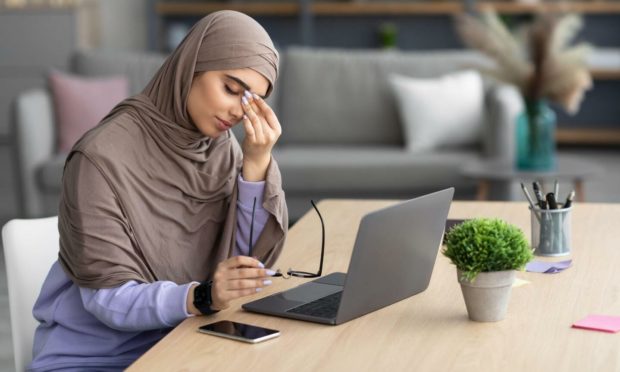Do your eyes sometimes feel dry, itchy or gritty, particularly when you’ve been staring at a screen? You could be one of the millions of people in the UK suffering from dry eye syndrome.
New research estimates up to six out of 10 adults suffer from dry eyes – a condition thought to have increased through the pandemic while people have been spending more time on screens, which is associated with the syndrome.
“If the problem’s really bad, dry eyes can cause blurry vision, from mucous that’s not washed away by tears,” explains consultant ophthalmic surgeon Mr Badrul Hussain.
“Using a screen itself won’t cause dry eyes, but if you’re concentrating on the screen, you don’t blink as frequently, and your tears can evaporate more quickly.”
Research by eye-care company Rohto found more than half (55%) of adults stare at a screen for five to seven hours a day, while 36% do so for eight to 12 hours. Yet just seven out of every 100 people questioned took the recommended amount of screen breaks.
“Dry eye is caused by a lack of lubrication in the eye – either due to staring at a screen for hours without a break, and a lack of blinking, or because the tear glands aren’t working effectively,” notes optometrist Francesca Marchetti.
She recommends people who work on screens use the the 20-20-20 rule, by giving eyes a screen break every 20 minutes and looking at a distant object (20ft away) for 20 seconds, and then blinking for 20 seconds.
Both Marchetti and Hussain say it’s vital to tackle dry eye early, both to treat discomfort with lubricant eye drops, and also to prevent long-term damage developing from severe dry eyes.
Here, Hussain and Marchetti explain what causes dry eyes and how to treat them.
What is dry eye syndrome?
Every time we blink, tiny glands in the eyelids release a thin layer of tears made up of three layers (oily, watery and mucous) to coat the surface of the eye (cornea) and provide it with nutrients. But if insufficient tears are produced, they’re not of good enough quality, or they don’t spread across the eye properly, the eye becomes dry. Those tiny dry patches will feel uncomfortable, and will be irritated each time you blink.
What are the symptoms of dry eye?
Experts say symptoms, which can occur in one or both eyes, can obviously include a dry feeling in the eye, as well as stinging, redness, feeling like you’ve got grit in your eyes, difficulty wearing contact lenses, blurry vision and even – bizarrely – watery eyes, which is the body’s natural response to the irritation of dry eyes.
“Symptoms of dry eye are a particular problem for contact lens wearers,” says Marchetti.
What causes dry eye?
Dry eyes are caused by many different things, explains Hussain, including certain medical conditions like rheumatoid arthritis or Sjögren’s syndrome (which affects moisture secreted by the body), surgery or eye trauma, infection or inflammation of any of the glands around the eye, or an infection of the eyelash roots (blepharitis).
Ageing also makes you more likely to get dry eyes, as Marchetti says from middle-age, the body produces less hyaluronic acid, which is important for retaining moisture in the eyes. Hormonal changes during the menopause, and regular use of certain drugs including antihistamines, antidepressants and diuretics, can also affect the amount of moisture in the eyes, she says.
Hussain says: “Some people aren’t making enough tears because they have medical conditions. But having dry eye from such medical conditions isn’t as likely as evaporative dry eye, which can happen when the oily layer of the tear film isn’t as good, and is by far the most common reason for dry eyes. This can happen as we get older.”
How do you treat dry eye?
Hussain says most people don’t have severe dry eye thankfully, and many will be able to make their eye feel comfortable by regularly putting in over-the-counter lubricating drops.
“For most people, dry eye is a nuisance, but not something that’s going to have a huge effect on their life,” he says. “For a lot of people, it’s going to the chemist and getting lubricating drops. If you have any worrying symptoms, or changes in symptoms, along with significant pain, you need to see a GP or an optician.”
For severe cases of dry eye, steroid medication may be prescribed, or other eye drops which can help increase tear production. Rarely, autologous serum may be prescribed – these are drops made from a patient’s own blood, which is spun to separate the serum in it from the rest of the blood. The serum is then mixed with saline and returned to the patient as eye drops.
Additionally for severe dry eye, Hussain says tiny plugs, called punctal plugs, made of collagen or plastic, can be inserted into tear ducts on the lower lid to stop tears draining away.




